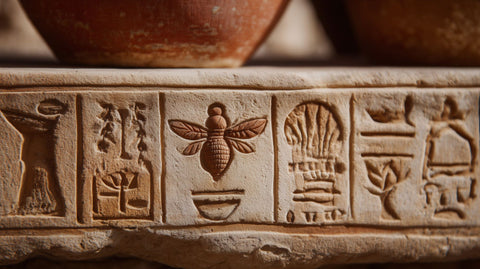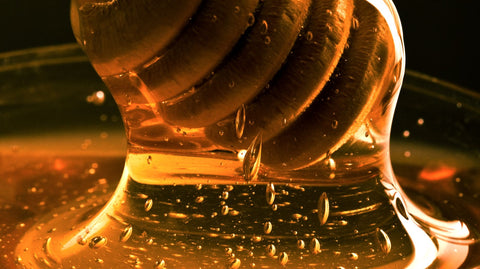Beeswax has been used for thousands of years in art, religion, medicine, and daily life, from Egyptian mummification and Roman sculpture casting to medieval church candles and folk remedies. Today, it remains valued for its purity, symbolism, and eco-friendly role in modern products like candles, wraps, and skincare.
Produced by honeybees inside the hive, it is a natural substance with unique qualities that have made it invaluable across cultures and centuries. From preserving ancient writings to shaping fine art, from lighting sacred ceremonies to protecting everyday household items, beeswax has served both practical and symbolic purposes.
The story of beeswax is not just about a natural product. It is about human ingenuity, spirituality, craftsmanship, and sustainability. Exploring the history and traditions of beeswax use helps us appreciate why this material remains important today, even in a world filled with synthetic substitutes.
Ancient Origins of Beeswax
The earliest records of beeswax use go back to some of the world’s oldest civilizations. Archaeological evidence shows that bees and humans have shared a close relationship since prehistoric times. Beeswax, being versatile and long lasting, became one of the earliest natural substances to be harvested and adapted for human needs.
Beeswax in Ancient Egypt
Egyptians were among the first to recognize the value of beeswax. It played a central role in their religious and cultural practices. Beeswax was used during the process of mummification to seal and protect bodies from decay. Priests also burned beeswax candles in temples as offerings to the gods, believing the light and purity of beeswax carried spiritual meaning.
Beeswax was not only sacred. It was practical. Egyptians used it as a preservative for documents and for coating papyrus scrolls. It also appeared in cosmetics, skin treatments, and even in medicine. Archaeological finds include small figures and amulets crafted from beeswax, which were believed to hold protective powers.
Beeswax in Ancient Greece and Rome
The Greeks and Romans expanded the uses of beeswax further. A famous example is the “lost-wax” casting technique. This method used beeswax to create molds for intricate bronze sculptures. Once melted away, the beeswax left space for molten metal, allowing artists to produce remarkably detailed works of art. This method is still used today, proving how enduring the technique has been.
In everyday life, beeswax had a presence in writing and communication. Greeks and Romans used beeswax tablets as reusable writing surfaces. A wooden frame held a thin layer of wax that could be inscribed with a stylus, smoothed over, and reused many times. This simple but effective technology made record keeping and education more practical.
Romans also recognized beeswax for its ability to preserve and protect. They used it to waterproof ships, seal containers, and preserve food. Wealthy Romans preferred beeswax candles over tallow because of their cleaner burn and pleasant aroma. These early candles lit both temples and homes, highlighting the material’s importance in both sacred and domestic life.
Beeswax in Religious and Spiritual Traditions
Beyond its practical uses, beeswax has carried deep spiritual meaning. Across religions, it has often symbolized purity, light, and connection to the divine.
Christianity and the Symbolism of Beeswax
In Christian traditions, beeswax candles became central to religious rituals. The purity of beeswax symbolized the purity of Christ. During Easter, the Paschal candle, often made of beeswax, plays an important role in services. Its flame represents the resurrection and eternal light.
Beeswax candles were considered superior to other types because of their natural clarity, long burn time, and pleasant scent. Many churches required beeswax candles for their altars, reinforcing the material’s spiritual symbolism. This tradition has continued in many denominations to this day.
Spiritual Uses Across Cultures
Outside Christianity, beeswax has appeared in rituals and offerings across the globe. In Hindu traditions, beeswax was sometimes used in sacred lamps, representing light that removes ignorance. In some indigenous cultures, beeswax figurines or offerings symbolized protection and fertility. The universality of beeswax as a symbol of purity and transformation shows how deeply humanity has valued this natural substance in spiritual life.
Practical Uses in Daily Life Across History
Beeswax was not only sacred. It was also an essential part of everyday life in many societies.
Beeswax in Medieval Europe
During the Middle Ages, beeswax continued to hold both spiritual and practical value. Beeswax candles were prized because they burned brighter and cleaner than those made from animal fat. However, they were expensive and typically reserved for churches, monasteries, and the homes of the wealthy. Ordinary households often relied on cheaper, smoky tallow candles, while beeswax remained a luxury.
Guilds and trades also benefited from beeswax. Scribes used it to seal manuscripts and protect pages from moisture. Craftsmen found that beeswax preserved wood, leather, and metal. It served as a polish, a lubricant, and even as a waterproofing agent. In this era, beekeeping was an important occupation, since both honey and beeswax were highly valuable commodities.
Preservation and Household Applications
As households grew more advanced, beeswax became a tool for protection and preservation. It was used to coat cheeses, preventing spoilage and keeping them fresh longer. Wooden furniture polished with beeswax not only gained a shine but also received a protective barrier against damage. Even today, beeswax polish remains a trusted natural option for maintaining furniture and woodwork.
Artistic and Scientific Contributions
The influence of beeswax extended into the worlds of art and science.
Art and Sculpture
The lost-wax casting method deserves special attention because of its long-lasting impact. From ancient civilizations to Renaissance Europe, artists relied on beeswax to create molds for their masterpieces. The level of detail possible with beeswax allowed for extraordinary craftsmanship in both small ornaments and monumental sculptures.
Wax modeling also became an important technique in Renaissance art education. Apprentices used wax to practice anatomy and create lifelike figures. This material helped bridge the gap between natural observation and artistic representation.
Medicine and Science
In medicine, beeswax was used in ointments and salves for its soothing and protective qualities. Ancient healers recognized its ability to form a protective barrier on the skin. Apothecaries mixed it with oils and herbs to create treatments for wounds, burns, and skin irritations.
Scientists also benefited from beeswax. It was used in the preservation of specimens, sealing of containers, and experiments with waterproofing and preservation. Beeswax proved invaluable in laboratories and workshops long before the invention of modern plastics and synthetic materials.
Beeswax in Folk Traditions and Everyday Practices
Not all uses of beeswax were monumental. Many traditions developed around beeswax in ordinary households and communities.
Remedies and Home Crafting
Generations passed down recipes for beeswax-based remedies. Families made lip balms, hand salves, and protective ointments from beeswax combined with natural oils. These simple remedies reflected both the practicality and accessibility of beeswax.
Candle making also became a cherished household skill. In many communities, making beeswax candles was a seasonal activity, often tied to religious festivals or preparations for winter. The scent of freshly made beeswax candles became associated with family traditions and holiday celebrations.
Folk Art and Decorative Traditions
Beeswax also appeared in folk art. In some cultures, beeswax was used to create decorative figurines, molds, or carvings. It became part of wedding traditions, festivals, and celebrations. The flexibility of beeswax made it ideal for artistic expression in communities where access to more refined materials was limited.
The Evolution into Modern Times
Beeswax did not disappear with the rise of industrialization. Instead, its uses evolved alongside new technologies.
The Industrial Revolution
During the Industrial Revolution, the production of paraffin wax made candles cheaper and more widely available. Paraffin candles quickly replaced beeswax in most households because of their lower cost. However, beeswax candles remained preferred in churches and among those who valued their quality and symbolism.
Beeswax also found a place in emerging industries. It was used in machinery as a lubricant and sealant. It became an ingredient in early cosmetics, such as creams and pomades. Its waterproofing qualities continued to be valuable in manufacturing.
Beeswax in Modern Sustainability
In the modern era, beeswax has experienced a revival, largely due to the growing interest in natural and sustainable living. Beeswax wraps have become a popular alternative to plastic wrap, offering an eco-friendly way to preserve food. Natural skincare companies rely on beeswax in lip balms, lotions, and salves. Artisans use it in handmade candles, marketed for their clean burn and natural fragrance.
Consumers increasingly value beeswax for being biodegradable, renewable, and safe. In a time when synthetic products dominate, beeswax stands out as a reminder of the effectiveness of natural resources. Its return to popularity highlights a cultural shift toward sustainability and appreciation for traditional practices.
The Symbolism of Beeswax Across Cultures
Throughout history, beeswax has carried meanings that extend beyond its physical properties.
In many cultures, beeswax represents purity. Its natural clarity and clean burning have made it a symbol of truth and light. In spiritual settings, beeswax has symbolized a connection between humans and the divine.
Beeswax has also represented resilience. Bees produce it through tireless work, and humans have relied on it for millennia. This connection between bees and humans reflects themes of cooperation, sustainability, and respect for nature.
By honoring beeswax, cultures have also honored the bees themselves. The traditions of beekeeping and honey harvesting are deeply connected to the survival of communities and ecosystems. Beeswax, as a byproduct of this relationship, becomes a symbol of harmony between people and the natural world.
Final Thoughts About the History of Beeswax
The history and traditions of beeswax use reveal a story of human creativity, spirituality, and survival. From the tombs of ancient Egypt to the workshops of Renaissance artists, from the altars of medieval cathedrals to the eco-conscious homes of today, beeswax has shaped human life in countless ways.
It has preserved sacred texts, illuminated ceremonies, protected food and furniture, inspired artists, and healed wounds. Even as modern technology introduced cheaper substitutes, beeswax remained valued for its natural qualities and enduring symbolism.
Today, as people search for sustainable and natural alternatives, beeswax continues to thrive as a timeless resource. It reminds us that many of the best solutions come directly from nature. For those who want to experience beeswax in its purest form, Ames Farm offers high-quality beeswax products and honey straight from the hive, carrying forward a tradition that connects us to the past and supports a sustainable future.
Frequently Asked Questions About The History of Beeswax
What is beeswax and how is it made?
Beeswax is a natural substance secreted by honeybees to build the honeycomb inside their hives. Worker bees produce thin flakes of wax from special glands, which they then shape into the hexagonal honeycomb cells used for storing honey, pollen, and brood.
Why was beeswax so important in ancient civilizations?
Ancient civilizations valued beeswax for its versatility and symbolic meaning. Egyptians used it in mummification, rituals, and cosmetics. Greeks and Romans used beeswax for writing tablets, sculpture casting, candle making, and waterproofing. Its ability to preserve, protect, and symbolize purity made it essential across many aspects of life.
Why are beeswax candles special compared to other types?
Beeswax candles burn longer, cleaner, and brighter than tallow or paraffin candles. They release a natural, subtle honey scent and produce very little smoke. In religious traditions, beeswax candles were seen as symbols of purity and light, which is why they were often required for church rituals.
How has beeswax been used in folk traditions?
In households and communities, beeswax was used for making candles, salves, ointments, and balms. Families passed down recipes for beeswax remedies, while artisans used it in crafts and decorative figurines. In many places, beeswax candle making became a seasonal or holiday tradition.


